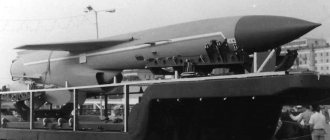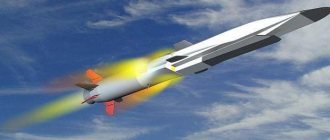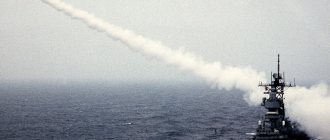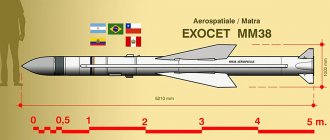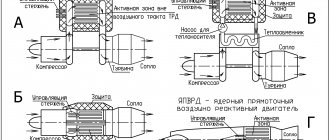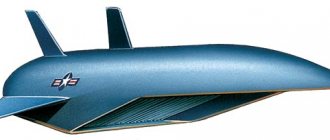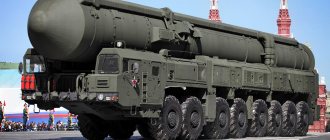If during the Cold War era, the USSR and the Warsaw Bloc member countries paid more attention to the development of ground forces and the improvement of missile weapons, then aircraft carriers became a symbol of the military power of the United States and the NATO bloc. Carrier strike groups (ACGs) were and remain the main striking force of the US Navy, which allowed this country to conduct military operations anywhere in the world.
For the USSR, American AUGs became a real headache. For many reasons (primarily due to lack of funds), the Soviet Union could not oppose America with anything similar, but it needed the means to effectively fight American aircraft carriers. Throughout the years of the Cold War, the Soviet military-industrial complex was looking for an asymmetric response to this American threat. Anti-ship cruise missiles, the development of which began in the mid-50s, were especially well suited to the role of “aircraft carrier killer.”
It is thanks to the decades spent on design developments in this area that today Russia has the best anti-ship missiles in the world, one of which is the P-700 Granit. No other country in the world has anything like it: these anti-ship cruise missiles are significantly superior to their foreign competitors in terms of flight range, warhead weight, speed, and other characteristics.
History of creation
The first cruise missile that was put into service, mass-produced and participated in combat operations was the German V-1. The Germans used it at the end of the war against Great Britain, but this weapon could no longer change the course of hostilities.
After the end of World War II, German rocket technology fell into the hands of the Allies and became the basis for their own further developments. In the USSR, the talented rocket designer Vladimir Chelomey and his colleagues worked in this direction.
Cruise missiles looked especially promising as a means of combating enemy aircraft carriers. In 1959, the USSR adopted the P-5 anti-ship cruise missile (ASC), created under the leadership of Chelomey, and designed to destroy enemy surface ships, including aircraft carriers. The missile could carry a nuclear charge.
The P-5 had a speed close to the speed of sound, a warhead weighing one ton, and a flight range of 500 kilometers. Very good characteristics, even today, but there was one problem: this missile could only be fired from a surface position. This deprived the attacking submarine of its main advantage - stealth. It was necessary to look for an alternative solution.
The development of a new missile system began in 1969. Chelomey proposed creating a single complex to arm both submarines and surface combat ships. The new missile was supposed to be able to launch underwater and have a high flight speed and range. The missile system was named “Granit”; its development took almost fifteen years.
Flight design tests of the new rocket began in 1975, and state tests began in 1979. In 1983, the P-700 anti-ship complex was put into service.
When developing the P-700 missile, all experience in the production and use of such weapons was taken into account. The designers worked out all possible design options for the future rocket, its control system, placement and launch from a submarine.
The P-700 was adopted by the Project 949 Granit and 949A Antey submarines, as well as the 1144 Orlan, 1144.2 Orlan and 1143.5 Krechet surface ships.
Granit anti-ship missiles are still in service with the Russian Navy today, although they are already considered obsolete. Similar weapons are installed on Project 949A Antey nuclear submarine cruisers (24 anti-ship missiles on each). The flagship of the Northern Fleet, the heavy nuclear-powered cruiser Pyotr Velikiy, is armed with twenty Granit cruise missiles, and another 12 are installed on the aircraft-carrying cruiser Admiral Kuznetsov.
The P-700 Granit has never been used in real combat; experts have different views on the effectiveness of this weapon.
P-700 "Granit" (3M45) - anti-ship missile system
In 1969, the TsKBM Ministry of General Engineering (OKB-52 in Reutov) began developing the Granit long-range anti-ship missile. Back in the mid-60s, during the development of the Amethyst and Malachite complexes, General Designer V.N. Chelomey came to the conclusion about the need and opportunity to take a new step towards universalizing launch conditions for long-range missiles.
Device
The Granit rocket is made according to a normal aerodynamic design; it has a cigar shape, the annular air intake is located in the front part of the rocket.
The P-700 is equipped with folding, highly swept wings located in the central part of the fuselage, as well as a cross-shaped tail unit (it also folds out).
The missile is equipped with a KR-21-300 sustainer turbojet engine located in its rear part. Over most of its trajectory, the missile travels at 1.5 times the speed of sound (Mach 1.5), making it much more difficult to detect and destroy. At high altitudes, the P-700 can accelerate to 2.5 M. A ramjet engine was developed especially for Granit, which could accelerate the rocket to a speed of Mach 4.
It is especially worth highlighting the autonomous control system of this anti-ship missile system. The computer, which is the basis of the control system, has several information channels; it is capable of successfully resisting electronic warfare.
The P-700 Granit missile is located in a special launch container, which is filled with sea water before launch to equalize the pressure (this also happens on surface ships). Then, with the help of special solid propellant boosters, the P-700 reaches the surface of the water. In the air, the main engine begins to operate, the wings and tail stabilizers open.
"Granit" can be equipped with various types of warheads. This could be a high-explosive penetrating warhead weighing up to 750 kilograms. The missile can also be equipped with a nuclear warhead with a yield of up to 500 kilotons.
The guidance head is active, radar type.
P-700 “Granit” is a very “intelligent” missile. Immediately after launch, it rises to a high altitude and detects its target. After this, the missile descends to the lowest possible altitude and follows it until it hits the target. This flight mode greatly complicates the work of enemy missile defense.
Granit missiles can hunt their prey in a “flock”. The first P-700 locks onto a target (or targets) and points all other missiles at them. Each of them receives its own target, but if the guidance missile is destroyed, then another member of the “flock” takes over its functions. Missiles classify targets according to importance, choose the most optimal attack tactics and plan. The electronic control system of the missile contains data from all modern ships and methods for countering attacks. Missiles approaching a target constantly exchange information with each other.
All this allows the P-700 to decide what is in front of it: an AUG, a regular convoy or a landing group, and act accordingly. If a ship is destroyed by one missile, then the rest choose other targets.
Each missile is equipped with a radar jamming device and can emit decoys.
The rocket launches from a special container, which is installed at an angle of 47º.
Design
The P-700 Granit missile has a cigar-shaped shape with an annular air intake at the front end and a folding cross-shaped tail unit. A short, highly swept wing, foldable after launch, is installed in the central part of the fuselage.
The rocket is propelled by a KR-21-300 turbojet engine located along the central axis. The rocket is launched from under water using a block of four solid fuel boosters located behind the rocket. The missile is stored in a sealed transport and launch container with folded wings and tail surfaces, the air intake is covered with a dome-shaped fairing. Before launch, the installation is filled with sea water (this procedure is also used on surface ships to avoid damage to the installation by exhaust), after which the activated accelerator pushes the rocket out of the shaft and delivers it to the surface of the water. In the air, the air intake fairing is discarded, the wings and tail are straightened, the burnt-out accelerator is discarded and the rocket continues to fly with the help of the main engine.
The missile is equipped with warheads of various types. This can be either a semi-armor-piercing (high-explosive-penetrating) warhead weighing 584-750 kg, or a tactical nuclear warhead with a TNT equivalent of up to 500 kilotons. The missile is guided using an active radar guidance head. The on-board autonomous selective control system for anti-ship missiles is built on the basis of a three-processor on-board computer (OBC) using several information channels, which allows one to successfully understand a complex interference environment and identify true targets against the background of interference. During a group launch of missiles (salvo), the missiles, having detected the enemy with their homing heads, exchange information, identify and distribute targets by their size, relative position and other parameters. The on-board computer contains electronic data on modern classes of ships; tactical information, for example, about the type of orders of ships, which allows the missile to determine that in front of it is a convoy, aircraft carrier or landing group, and attack the main targets in its composition; data on countering enemy electronic warfare systems that can divert missiles from the target by jamming them; tactical techniques for evading air defense fire.
To increase combat stability, the P-700 is equipped with a 3B47 “Kvarts” radio jamming station and devices for resetting dipole reflectors and decoys.
Specifications
Description
| Designation | Complex | P-700 "Granite" | |
| Rocket | 3M45 | ||
| Control system | inertial with active radar guidance | ||
| Dimensions and weight | |||
| Length, m | 10 | ||
| Wingspan, m | 2,6 | ||
| Diameter, m | 0,85 | ||
| Starting weight, kg | 7000 | ||
| Warhead type | high-explosive-cumulative | nuclear (500 kt) | |
| Warhead mass, kg | 750 | ||
| Power point | |||
| Main engine | TRD KR-93 | ||
| Flight data | |||
| Speed, km/h | on high | 2800 (2,5) | |
| near the ground | (1,5) | ||
| Launch range, km | 550 (625) | ||
| Minimum flight altitude, m | 25 | ||
| Ceiling, m | 14000-17000 | ||
Project evaluation
For its time, the P-35 and its modifications were an effective and dangerous weapon. Guidance using a radio sight made it possible to select a target and select interference with much greater accuracy than the automation of that time could allow. The high speed of the rocket made it almost impossible to intercept it with artillery fire, and the powerful warhead made it possible to hit ships of any class at a significant distance for that time.
However, the missile had a number of disadvantages, the main one of which was the high altitude of the sustainment phase of the flight, which made it easier to detect the missile by enemy radars. Long-range anti-aircraft missile systems like the RIM-8 Talos could hit the P-35 at distances of up to 100-150 km while still on the march. In addition, the speed of the missile was lower than the speed of its contemporary fighters (which by the early 1960s had already reached speeds of M=2), which allowed carrier-based interceptors to shoot it down on the march.
Comparison with other anti-ship missiles
If we compare the Granit missile system with its foreign analogues, we must admit that this missile is the best today.
The launch weight of the 3M45 missile is ten times (!!!) greater than the similar parameters of the American Harpoon anti-ship missile. Also, “Granit” is more than twice as large as the American in terms of warhead mass, and twice as fast. The P-700 has a five times greater range.
There is an even greater difference in characteristics with the French Exocet anti-ship missile, the Chinese S-802 and the Israeli Gabriel.
The destructive power of the 3M45 missile allows one hit to destroy a modern destroyer or cruiser. To guarantee the destruction of an aircraft carrier, 8-10 such missiles are needed.
These Soviet missiles are really good and have no analogues in the world, but there is one problem associated with detecting a target and aiming the P-700 anti-ship missiles at it. It is she who is the “Achilles heel” of this complex. This makes us doubt that Granit missiles can sink a modern aircraft carrier.
Notes
Sources
- Konstantin Danilov.
. Of. NPO Mashinostroyenia website (July 19, 2013). Retrieved August 6, 2013. - ↑
- . MilitaryRussia.Ru.
- . (2010-2017). Retrieved May 13, 2022.
- . Army and defense industry
. ITAR-TASS (02/19/2016). - “... the cruiser will be equipped with ten 3S-14 launchers, which will be able to receive Onyx, Caliber and Zircon missiles.” Retrieved February 19, 2016.
- (unavailable link). Retrieved June 26, 2008.
Comments
- Data varies.
- In the early stages of development, it was planned to use a radar sight with data relay to the carrier ship for command guidance.
- Currently, the Legend ICRC is not functioning; its functions are performed by the Liana ICRC complex.
Can Granit destroy a modern AUG?
Disputes regarding the P-700's ability to hit an aircraft carrier have been going on for quite some time. Theoretically, Granit anti-ship missiles pose a great danger to any warship, including an aircraft carrier. But there is one problem that reduces all the advantages of this missile to almost zero. This is targeting.
When firing at long distances, the P-700 homing head cannot independently lock onto a target; it needs target designation, which theoretically can be carried out from airborne vehicles or from space.
To destroy an enemy AUG using Granit, a Russian submarine or surface ship must detect and classify the target, approach it within salvo range, and fire missiles that can hit enemy ships. It should not be forgotten that carrier strike groups are very difficult targets. They are extremely protected by a wide variety of air defense, missile defense and electronic warfare systems, constantly maneuver, have a powerful aviation group, and are covered by submarines. Hitting this target (and even getting close to it within the range of a missile salvo) is very difficult.
The current Russian fleet is extremely limited in terms of target detection. Their detection radius is usually limited by the radio horizon. The helicopters that some Russian warships have are of little use for solving this problem, primarily due to their short range. It is ineffective to carry it out using the Tu-95RTs aircraft, since a reconnaissance aircraft sometimes needs a large number of hours to arrive in a certain area of the World Ocean.
During Soviet times, the use of nuclear submarine cruisers equipped with Granit anti-ship missiles was based on a powerful naval reconnaissance system, which had information about a potential enemy in all zones of the ocean theater of operations.
Its basis was ground-based radio intelligence centers located both on the territory of the USSR and beyond its borders. You can recall similar centers located in Cuba, Vietnam (Cam Ranh), and South Yemen. Today there is none of this.
In addition to ground bases, the Soviet Union had an effective space reconnaissance and target designation system that could detect an enemy ship almost anywhere in the World Ocean. And not only to detect: this system constantly monitored the AUG of a potential enemy and, in the event of war, could provide target designations for missile weapons.
The Granit anti-ship missile system can be called only one of the components of the Soviet aircraft carrier destruction system; its second element was the Legend space target designation system. It began to be developed in the mid-70s under the leadership of Academician Keldysh.
The Legend project consisted of creating a satellite constellation in low-Earth orbit capable of transmitting information about the movement of surface targets and producing target designations for missile weapons. This group included both active (radar) and passive (bearing of objects) reconnaissance devices. The Legend system was capable of targeting Soviet missiles at any point on the earth's surface.
However, at the moment, “Legend” has long been history. In 1998, the last satellite constellation completed its work. Currently, a similar system “Liana” is in the formation stage.
Therefore, any Russian ship equipped with Granit anti-ship missiles will be detected much earlier than it can approach the launch distance of these missiles. If we talk about launching missiles from a submarine, then this has its own difficulties.
To fire a successful salvo of P-700 missiles, the submarine must enter the near zone of the anti-submarine defense order, where the probability of detecting a submarine will be very high. Even with a successful missile launch, not all of them will be able to achieve their goals, since the AUG has very strong air defense and missile defense.
Today, the likelihood of the destruction of an American aircraft carrier by any means of attack at the disposal of the Russian Navy seems very unlikely. Without resuscitating the global intelligence system, this will be very problematic. Unless nuclear warheads will be installed on the missiles.
Application[ | ]
The missiles are launched from containerized inclined launchers SM-225 (for submarines) or SM-233 (for surface ships), located under the deck of the carrier ship at an angle of 60 degrees. Before launch, to reduce thermal loads on the launcher, the container is filled with sea water[3].
When firing at a long range (more than 100-120 km), missiles rise to an altitude of about 14-17 thousand meters and perform most of the flight at it in order to reduce air resistance (and, accordingly, fuel costs) and increase the target detection radius of the seeker [note 2]. Having detected a target, the missiles carry out identification, distribute targets among themselves and then descend to a height of 25 meters, hiding behind the radio horizon[4] from the radars of the carrier ship, after which they follow at low altitude with the seeker switched off, turning them on again only for precise guidance directly before the attack. An attack on a formation is organized in such a way that the destruction of secondary targets occurs only after the destruction of priority ones, and in such a way that one target is not attacked by more than the number of missiles necessary to defeat it. At the same time, anti-ship missiles use programmed tactical techniques to evade air defense fire, and also use on-board electronic countermeasures.
Since the long-range flight time of a missile is significant, and the target can go beyond the detection radius of the missile seeker, the complex needs precise target designation carried out by the “Success” aviation complex from Tu-95RTs aircraft or Ka-25Ts helicopters, or by the space reconnaissance and target designation complex ICRC "Legend"[note 3] The missile can also be used to destroy ground targets[5].
Modifications
P-6
Modification of the P-35 missile for firing from submarines on the surface. Telecontrol and transmission of images of the target environment to the control panel of the carrier were used. For the first time, the problem of selectively hitting a moving target at long range, including when firing a full load of ammunition, was solved. The complex was designed to destroy surface ships (NS) located beyond the radar horizon and was created as an integral part of the reconnaissance and strike system, which also included the US-A and US-P satellites for receiving information from the waters of the World Ocean, a central point for processing and distributing information , a point for developing target designation and transferring them to the firing submarine. The complex was adopted by submarines in 1964. The development and creation of the complex was awarded the Lenin Prize.
The missile differed from the P-35 in the design details of the air intake and the guidance system: due to the impossibility of a submarine to communicate effectively with the missile at a long distance, the signal from the radio sighting device was relayed from the missile to the submarine using a Tu-16RTs, Tu-95RTs relay aircraft or a Ka-25Ts helicopter . The missile also differed somewhat from the P-35 in weight and dimensions. The relay system was put into service in 1965: before that, long-range firing of the P-6 was possible only in autonomous homing mode.
Progress
The 3M44 Progress missile is the result of modernization of the sea-based missile system with P-35 anti-ship missiles adopted by the Navy, aimed at increasing combat effectiveness by improving the control system while maintaining the appearance and main systems of the P-35 anti-ship missiles. The complex is designed to destroy strike groups, cruisers, destroyers, landing ships and large enemy transports. Firing range increased from 270 to 460 km. The Progress complex was put into service in 1982.
The main difference between the 3M44 and the basic modifications was the improvement in the noise immunity of the communication channel with the carrier ship. The height of the final flight segment was reduced to 25 meters, which reduced the range of destruction of the missile by enemy short-range air defense systems, and the length of the final segment was increased from 20 km to 50 km. The missile was also equipped with an automatic target selection system and could carry out selection in the absence of an operator.
